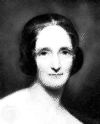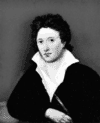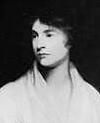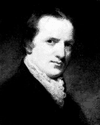 |
- MARY SHELLEY
Born on 30th August 1797, Mary Shelley was
the only child of William
Godwin, a philosopher
and novelist and Mary Wollstonecraft,
a clever
and erudite writer who
was an advocate of
equality between the sexes.
 Unfortunately she died ten days after Mary
was born. Two years later
her father married
M.J. Clairmont, a widow
with two daughters. Unfortunately she died ten days after Mary
was born. Two years later
her father married
M.J. Clairmont, a widow
with two daughters.
Mary was strongly impressed
by the brilliant
talks she listened to since
she was surrounded
by famous writers and philosophers.
The intellectual
environment in which she
lived stimulated
her Romantic sensibility
and the political
revolutionary ideas of
the time.
 She was a girl when she met Coleridge since
he was one of her father's
friends. In 1814,
at the age of sixteen,
she met the poet P.B.
Shelley who often visited
her house together
with his wife, Harriet
Westbrook. Mary fell
in love with him and they
began to meet secretly.
Because of public hostility,
even by her
father, they eloped to
France returning to
England after a few weeks. She was a girl when she met Coleridge since
he was one of her father's
friends. In 1814,
at the age of sixteen,
she met the poet P.B.
Shelley who often visited
her house together
with his wife, Harriet
Westbrook. Mary fell
in love with him and they
began to meet secretly.
Because of public hostility,
even by her
father, they eloped to
France returning to
England after a few weeks.
In 1815 Mary gave birth to a daughter, Clara,
who died a few days later.
In 1816 the Shelleys
went to Switzerland and
settled on the Lake
Geneva near Byron's villa
(Villa Diodati).
It was there that M. Shelley
had the idea
of writing her masterpiece,
Frankenstein, after the stimulating conversations on
literature and life she
had with Shelley
and Byron.
Back in England they got
married after the
death of Shelley's wife
who had committed
suicide.
In 1818 Frankenstein was published anonymously.
In the same year the Shelleys
travelled to
Italy. They spent some
time in Naples and
in Rome and then they moved
to Florence where
Mary gave birth to a son:
Percy Florence,
the only one to survive
infancy, since the
other two children she
had had were already
dead at that time.
Mary had already written
a novel Mathilda and at this time wrote Valperga. In 1822 they moved to Lerici where Percy
and one of his friends
drowned in a storm
during a sailing trip.
Mary was compelled to return
to England which
she despised because of
the conformism of
society.
Between 1826 and 1830 she
wrote The Last Man and Perkin Warbeck and she edited and publicised her husband's
literary works.
She spent her last years
with the family
of her son and died on
1st February 1851
of a brain tumour.
She is buried in Bournemouth.
|
- PERCY BYSSHE SHELLEY
Percy Bysshe Shelley was born in Sussex in
1792. His father
was an aristocratic
and
conservative  Member of Parliament. In spite of his wealthy
social conditions,
his childhood was
not
so happy. He was
not tolerant of authority
and very soon revealed
himself to have a
rebellious spirit,
rising against social
conventions and custom.
He attended Eton
College and there
he was given the
nickname
of "mad Shelley" or "Shelley the Atheist" because of his criticism of social
tyranny. In 1810 he went to Oxford University
from which, however, he was expelled for
writing a pamphlet called The Necessity of Atheism (1811). At the age of 19 he decided to go
and live in London since his father did not
give him any financial support, there he
met a sixteen-year-old Methodist girl, Harriet
Westbrook, who later became his wife. Their
marriage lasted three years and during this
period they moved from place to place, including
Ireland where Shelley was a political activist
in the cause of emancipation from British
rule. His rebellion against institutions
and religion was more and more evident. Back
in England he became associated with the
radical philosopher William Godwin and in
his household he met Mary, Godwin's daughter.
They fell in love with each other and so
in 1814 he eloped with her first to France
and then to Switzerland abandoning Harriet
and his two children. On returning to London,
Shelley found himself condemned as an immoral
atheist and when Harriet committed suicide
in 1816 he was denied custody of the children.
In December of the same year Shelley married
Mary and lived for a short period at Great
Marlow, in Buckinghamshire. Shelley left
England for Italy in 1818, and here wrote
his best work Ode to the West Wind (1819), To a Skylark (1820), The Cenci (1819) a verse tragedy, Prometheus Unbound (1820 ) a lyrical drama, Adonais (1821) an elegy, A Defence of poetry (1821) an unfinished essay. Member of Parliament. In spite of his wealthy
social conditions,
his childhood was
not
so happy. He was
not tolerant of authority
and very soon revealed
himself to have a
rebellious spirit,
rising against social
conventions and custom.
He attended Eton
College and there
he was given the
nickname
of "mad Shelley" or "Shelley the Atheist" because of his criticism of social
tyranny. In 1810 he went to Oxford University
from which, however, he was expelled for
writing a pamphlet called The Necessity of Atheism (1811). At the age of 19 he decided to go
and live in London since his father did not
give him any financial support, there he
met a sixteen-year-old Methodist girl, Harriet
Westbrook, who later became his wife. Their
marriage lasted three years and during this
period they moved from place to place, including
Ireland where Shelley was a political activist
in the cause of emancipation from British
rule. His rebellion against institutions
and religion was more and more evident. Back
in England he became associated with the
radical philosopher William Godwin and in
his household he met Mary, Godwin's daughter.
They fell in love with each other and so
in 1814 he eloped with her first to France
and then to Switzerland abandoning Harriet
and his two children. On returning to London,
Shelley found himself condemned as an immoral
atheist and when Harriet committed suicide
in 1816 he was denied custody of the children.
In December of the same year Shelley married
Mary and lived for a short period at Great
Marlow, in Buckinghamshire. Shelley left
England for Italy in 1818, and here wrote
his best work Ode to the West Wind (1819), To a Skylark (1820), The Cenci (1819) a verse tragedy, Prometheus Unbound (1820 ) a lyrical drama, Adonais (1821) an elegy, A Defence of poetry (1821) an unfinished essay.
Unfortunately, in
1822 while sailing
back
home from Leghorn
with his friend Edward
Williams and a sailor-boy,
he was caught
in a storm off Viareggio,
and the three were
drowned. The bodies
of the friends were
washed
ashore several days
later and in the
presence
of Byron, they were
burned after ancient
Greek fashion on
the sands near Viareggio.
Shelley's ashes were
placed in a box and
later buried in the
Protestant cemetery
in
Rome.
|
|
- MARY WOLLSTONECRAFT
|
"The divine right of husbands, like
the divine
right of kings,
it is hoped,
in this enlightened
age, be contested
without danger." |
|
from A Vindication of the Rights of Women, 1792 |
Mary Wollstonecraft, Mary Shelley's mother,
is well known as
an advocate of equality
between the sexes,
 in fact she led her life on the side of women.
In her famous book
A Vindication of the Rights of Women (1792) she attacks the system of women's
education affirming
that women are kept
in
a state of dependence
on men and are considered
as weak and passive.
She struggled to
affirm
the ideals of women's
emancipation and
equal
rights to men criticizing
the contemporary
morality and prejudices. in fact she led her life on the side of women.
In her famous book
A Vindication of the Rights of Women (1792) she attacks the system of women's
education affirming
that women are kept
in
a state of dependence
on men and are considered
as weak and passive.
She struggled to
affirm
the ideals of women's
emancipation and
equal
rights to men criticizing
the contemporary
morality and prejudices.
She was not "anti-men"
but against
the society which
creates women's submission
to men's authority:
"I love man as my fellow; but his sceptre,
real or usurped,
extends not to me,
unless
the reason of an
individual demands
my homage,
and even then the
submission is to
reason,
and not to man" .
Born in London on
April 27th, 1759
she left
home at the age of
twenty-one after
her mother's
death.
From 1783 to 1785
she was a teacher
in a
school that she ran
together with her
sister.
She then wrote a
book Thoughts on Education of Daughters (1787) in which she expressed avant-garde
ideas on the upbringing
of women. In the
same year she went
to Ireland to work
as
a governess in a
noble family but
she soon
returned to England
. She started writing
translations and
reviews for radical
magazines.
In 1792 she went
to Paris where she
met Gilbert
Inlay who was an
American writer,
and she
gave birth to a daughter
called Fanny. She
published a new book
A Historical and Moral View of the Origin
and Progress of the
French Revolution. She followed Inlay to Norway and published
her impressions about
the journey in Letters written during a short residence
in Sweden, Norway
and Denmark.
Inlay became indifferent
and unfaithful to
her and in 1796 she
returned to London
where
she attempted suicide.
Her sympathies were
always directed to
radical
circles, she then
met William Godwin,
a famous
radical writer, and
fell in love with
him.
They married in 1797,
but unfortunately
she
died in the same
year after giving
birth
to her daughter Mary,
the future novelist.
|
|
- WILLIAM GODWIN
William Godwin, Mary Shelley's father, was
born on March 3rd,
1756. He was at first
a Dissenting Minister,
but became an atheist
philosopher and a
radical who expressed
optimism
rooted in  confidence in the power of human reason.
He believed that
men acted according
to reason
and that rational
beings could live
in harmony
without laws or institutions.
His wife, Mary
Wollstonecraft, died
giving birth to Mary,
he then married a
Mrs Clairmont whose
daughter
by her first marriage
had a relationship
with Byron, bearing
him a child. confidence in the power of human reason.
He believed that
men acted according
to reason
and that rational
beings could live
in harmony
without laws or institutions.
His wife, Mary
Wollstonecraft, died
giving birth to Mary,
he then married a
Mrs Clairmont whose
daughter
by her first marriage
had a relationship
with Byron, bearing
him a child.
In his Enquiry Concerning Political Justice (1793) he stated that "Truth is omnipotent... Man is perfectible,
or in other words
susceptible of perpetual
improvement." He criticized society affirming that
all men are born
equal but they are
influenced
by the environment
in which they live,
so
a bad environment
gives origin to a
bad individual.
He asserted that
through reason man
can distinguish
between good and
bad environments
but man
must have the opportunity
to use it freely,
without any restaint.
He was a strong assertor
of the importance
which is to be given
to
education seen as
a means to get freedom
of choice. He was
a supporter of the
French
Revolution and spent
his life promoting
its
ideals and principles.
His work was almost
subversive even because
he affirmed that
all institutions
generate evil and
the reference
here is not only
to State and Church
but
also to school and
family. His writings
influenced
the Romantic poets.
He also wrote several
novels such as St. Leon (1799), Fleetwood (1805), Mandeville (1817), Cloudesley (1830) and Deloraine (1833). However, the most important was
Caleb Williams (1797), a remarkable novel of crime, detection
and psychological
study.
He died in London
on April 7th, 1836.
|
|
|
|